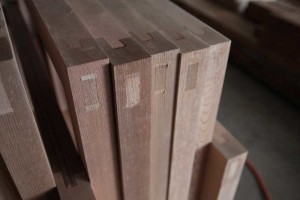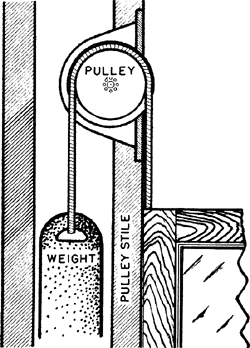Small Home Gazette, Winter 2014
Top Ten Reasons to Restore Original Wood Windows
1. Because your windows fit your house.
The original windows were designed to fit your house. They have expanded and contracted with the seasons. Replacement windows have a rigid structure that fits within your window openings. Gaps frequently open up around replacement windows resulting in more drafts than the original windows had.
2. Because you appreciate good craftsmanship.
 The true mortise and tenon construction of original windows is incredibly strong and even when it begins to weaken, is easily repaired. Antique windows were built to last and should not end up in a landfill.
The true mortise and tenon construction of original windows is incredibly strong and even when it begins to weaken, is easily repaired. Antique windows were built to last and should not end up in a landfill.
3. Because you value good materials.
Original wood windows are constructed of old growth timber. The wood is much denser and more weather-resistant than today’s tree-farmed softwoods.
4. Because you love the character of antique glass.
The glass in older windows may be roundel or cylinder glass, each indicating a certain era of manufacturing. Two layers of glass are better than one, and in older homes, that second layer of glass should be a storm window.*
5. Because you think a warranty should be more than 20 years.
Chances are your windows have done their job for 50 or more years already. Sure, they may be a little creaky and may not be as attractive as they once were, but it’s a far better investment to repair a proven performer than to sink money into a new window that only has a 20-year warranty at best. With proper maintenance, your antique windows should last another 100 years.
6. Because you want to avoid vinyl.
Polyvinylchloride (PVC) is becoming one of the greatest concerns in the building industry. Highly toxic dioxin is a byproduct of PVC production and is released if burned. Lead is used as a stabilizer in the manufacture of PVC. If you are concerned about our planet’s health, you should read up on efforts to reduce the use of vinyl.
7. Because you want more light.
Replacement windows are set inside the original window opening. On average, you get 15 percent less viewing area and therefore, less light. Who wants less light?
8. Because windows are a functional part of your house.
 Weights and pulleys are the best balance systems ever invented. If there is cold air in the weight pocket, it is generally because there is a gap between the outside trim of the house and the siding. Replacing easily serviceable weights and pulleys with vinyl jamb liners or invisible balance systems means installing a system that has a maximum life span of 10 to 20 years but generally fails in less time.
Weights and pulleys are the best balance systems ever invented. If there is cold air in the weight pocket, it is generally because there is a gap between the outside trim of the house and the siding. Replacing easily serviceable weights and pulleys with vinyl jamb liners or invisible balance systems means installing a system that has a maximum life span of 10 to 20 years but generally fails in less time.
9. Because you really can save 25 to 40 percent on heating costs.
The estimated first-year energy savings between a restored wood window with a good storm window vs. a replacement window is 60 cents. “The decision to renovate or replace a window should not be based solely on energy considerations, as the difference in estimated first-year savings between the upgrade options are small.”** Broken glass, failed glazing, no weather stripping—these small and repairable items are what really affect energy efficiency in windows.
10. Because the greenest building is one that is already built.
Older buildings represent a previous investment of energy in their manufacture; so-called embodied energy. When evaluating the entire production, shipping, installation and removal process, replacing windows consumes a lot of energy. Replacement windows are touted as a way to save energy. If the total energy expenditure to manufacture replacement windows is considered, the break-even period stretches to 40 to 60 years.
In the words of Richard Moe, president of the National Trust for Historic Preservation: “We can’t build our way out of the global warming crisis. We have to conserve our way out…; make better, wiser use of what we have already built.” Restoration work is done by local craftspeople— paying local taxes, using a minimum of materials and resources and a maximum of labor.
 Restoring windows is the best use of existing materials and the best way to support the local economy.
Restoring windows is the best use of existing materials and the best way to support the local economy.
* Department of the Interior Historic Preservation Briefs, brief #3 “Improving Energy
Efficiency in Historic Buildings.” www.nps.gov/tps/how-to-preserve/briefs.htm
** Shapiro, Andrew M. and Brad James. “Retain or Retire? A Field Study of the Energy Impacts of Window Rehab Choices.” Window Rehabilitation Guide for Historic Buildings. Ed. Charles E. Fisher, Deborah Slaton, and Rebecca A. Shiffer. Washington: Historic Preservation Education Foundation, 1997. IV-15 to IV-27.











